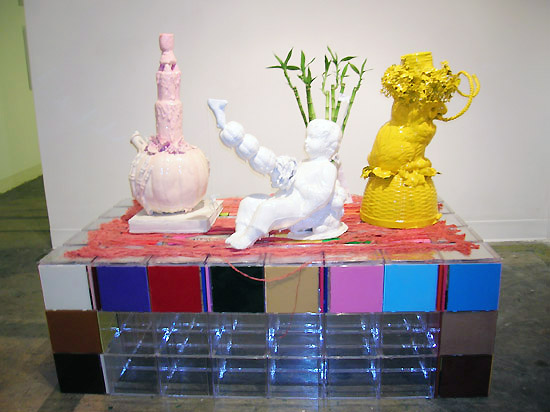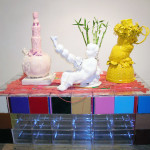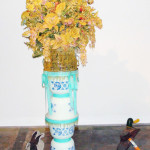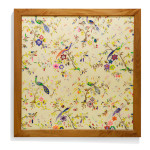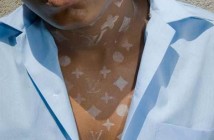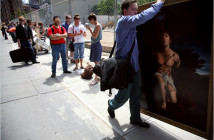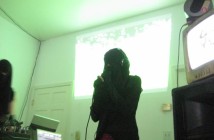ALEX DA CORTE @ LAMONTAGNE GALLERY
Alex Da Corte’s small show in the project room at South Boston’s LaMontagne Gallery is genre work for the outdated, contemporary American middle class split-level. His sculptural combines call to mind a familiar mise-en-scène, that taking place in the furnished basements of teenage America, the underworld inhabited by high school slackers from uninspiring suburbs. It is a hideout from responsibility, the demands of maturity, shag carpet for dreaming distant visions of the wild world elsewhere whilst smoking dope to make mom’s vaguely oriental wallpaper sparkle and shimmer as if it were some Far Eastern opium den.
There are some elaborately hand-built bongs, assembled out of variously odd found decorative objects, and treated to look like ceramic or porcelain. There are some amateur photographs carelessly placed around the bongs, night-time snapshots of street graffiti (one with an ironically appropriate sentiment “HOME SWEET HOME” scrawled on a wall in spray paint) and one cropped shot of a scraped up young man wearing only briefs who definitely seems drunk at a party. A Fiji brand water bottle crudely cut to serve as a vase holds a handful of Ikea bamboo stalks for just a touch of indoor greenery and a perfectly cheeky image of tropical exoticism available through cheap, mass-produced consumables. They also signify a half-baked attempt at making the room seem less disgusting, more thoughtful and livable. All are arrayed on top of a jewel-toned coffee table, which upon closer inspection is actually precariously constructed out of empty CD jewel cases. Mr. Da Corte calls this piece Gods and Monsters.
The “table” artily references a Sol Lewitt gridded cube, but more accurately resembles an awkward and obsolete pile of recorded music casings, plastic detritus occupying many a living room across this country. What once was the pride and joy of devoted pop music fandom, a glorious myriad of portable works of popular art and music, is now the kitschy display support for much more precious possessions.
Even as such, this jewel-case construction is also something like a mausoleum, a tomb for this defunct technology or better yet, a pantheon for all of the pop stars whose images have gone missing. I like to think they are the Gods.
The Monsters might be the bongs. These are terrifying, fat and phallic bongs, but I like thinking about Alex having to take a pottery class in order to make them. How quaint; how totally middle-American. Domestically confined hobbyists seem to do this sort of thing all of the time, and Da Corte’s alignment with the crafter cum tripped out drug enthusiast is very funny while also a little sad. I’m imagining some ambitious teenaged stoner making these things for the den in pottery class. The mixed media glaze is thick with saccharine and disappointment.
There is another sculpture titled Brideshead, which looks like a stunted Brancusi endless column made of common plastic planters with an off-white, blue, pink and gold silk flower arrangement affixed to the top. The “column” is trimmed festively with light blue ribbon and beading. Perhaps this is the faded bridal bouquet saved as a keepsake to remember the day when “till death do us part” was uttered deliriously as legally binding contract. Miss Havisham’s dusty plight also comes to mind.
It is worth noting that “Brideshead Revisited” was a really gay British television miniseries (and novel) about languorous, glamorous Brits hanging out at home. “Gods and Monsters” is a movie about gays hanging out at home too, set in Hollywood. In Da Corte’s exhibition scene, these titles linger like romances broadcasted on a nearby television.
My only criticism is that Da Corte was not afforded a larger space for Casual Luxury. His playfully vital and humorous sculptural parlor games work their uncommon magic best when let loose and writ large. He feels cramped in LaMontagne’s tiny project room. It is a minor quibble, however.
In the end, while Da Corte gorges on middle-America’s pathetic grasps for the exotic at home, he also is queering it. In his artist statement, Da Corte mentions wanting to glaze a stack of Abercrombie & Fitch Quarterlies, the scandalous and famously sexy catalogue for the clothier popular among young people. I believe they are there, serving as a base for one of the bongs. Encased and commemorated, the Quarterly sits, its promises of co-ed (and same-sex) teenage outdoor nudity, covered. Fetish looms large. Therein rests only some of the joyful and erotic potential hidden in an otherwise banal life spent at home.
- Alex Da Corte, Home Glorious, mixed media, 2009. Photo, courtesy LaMontagne Gallery.
- Ale Da Corte, Home Glorious, mixed media, 2009. Photo, courtesy LaMontagne Gallery.
- Alex Da Corte, Home Glorious, mixed media, 2009. Photo, courtesy LaMontagne Gallery.
"Casual Luxury" is on view until July 31st, at LaMontagne Gallery, located at 555 East 2nd St, in South Boston, MA .
All images are courtesy of the artist and LaMontagne Gallery.

